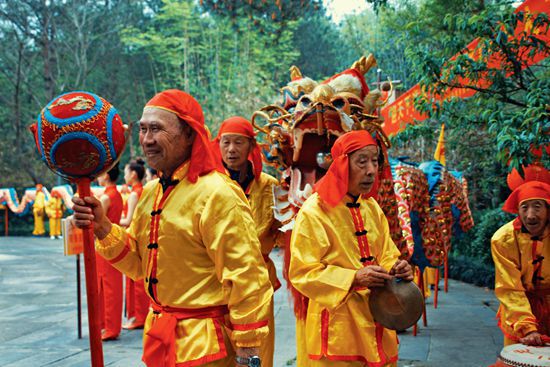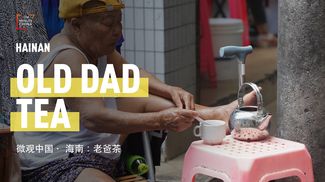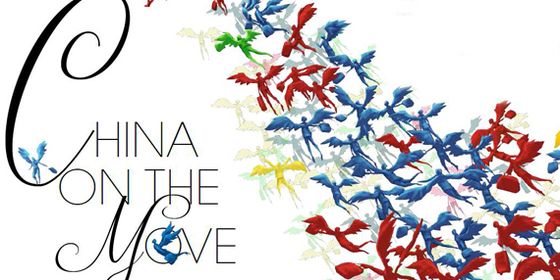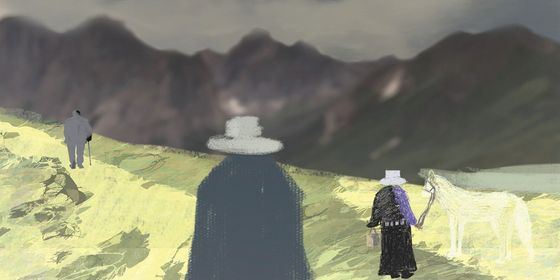“Characteristic towns” are China’s latest rural development strategy, but can every village truly be special?
Every spring before the Qingming “Tomb Sweeping” Festival, and again at the Chongyang “Seniors’ Day” in the fall, the retirees of Jinyun county dust off their gold costumes and practice ways of holding a mobile phone, umbrella, water bottle, and three-meters tall ceremonial flag in a two-hour outdoor parade.
The preparations lead up to a twice-annual “sacrificial rite” in Xiandu, the site where the legendary Yellow Emperor achieved immortality, an event that the county in Zhejiang province claims to have commemorated since prehistoric times.
The march of the seniors, though, was a more recent innovation: In 2006, the Jinyun government began inviting “folk art” troupes to perform at a revival of the ancient ceremony. In 2014, the event was named one of the “Three Great Zhejiang Province Ceremonial Activities” and evolved into today’s edition, which requires the participation of hundreds of local volunteers and even attracts “heritage-seeking” tourists from Taiwan.
“The development of small towns will have a brilliant future, if we can grasp the special characteristic of the town,” President Xi Jinping commented approvingly in 2015 on a document titled “The Research Report on Characteristic Towns in Zhejiang.” Submitted by the Ministry of Finance, the report proposed that the future of China’s rural development lay in local governments identifying one special local historical, cultural, or industrial component—and building economies around that single theme, based on the principle of “industrial clustering.”
Though the Yangtze River Delta is home to the earliest (and vast majority) of theme towns, officially called “characteristic small towns” (特色小镇) or “charming small towns” (风情小镇), the central government has recognized 403 such communities in 32 provinces as of 2017. By 2020, it hopes to raise their number to 1,000, in locations ranging from the remote Seriqbuya “Uyghur Bazaar” Town in Kashgar to Hengdian, “China’s Hollywood,” and Wuzhen, host of the annual World Internet Conference, on the prosperous eastern coast.

Tulips are blooming in Yancheng “Holland” Town, Jiangsu province, despite a crackdown on foreign-themed towns (VCG)
The themes, too, are eclectic: Qintong “Ancient Boat Race” Town in Jiangsu province, like Xiandu, capitalizes on lavish annual revivals of a traditional ceremony (and dresses local seniors in gold suits to do the rowing). Others rely on specialty produce or connections to famous figures, as in the respective cases of Changli “Grape” Town in Hebei province and Yucheng “Hua Mulan Culture” Town in Henan province.
Then there are towns with themes less tangible, like Yaxi “International Slow Living” Town in Nanjing or Nianhua Bay “Zen” Town in Wuxi; high-tech, as in Yunxi “Cloud Computing” Town in Zhejiang; or infamous, such as Zhejiang’s Datang “Charming Sock Industry” Town and Yucheng “Sex Toy” Town, officially known as “Happy Town.”
In turn, “charming towns” are part of an even larger initiative at the national level, one of many motley projects that, over more than a decade, have tried to reverse China’s growing urban-rural wealth gap, and the exodus of industry and population from its countryside.
In 2012, the Communist Party added the word “beautiful” to its definition of “socialism with Chinese characteristics,” originally stated by Deng Xiaoping as the building of a “rich, powerful, democratic, and civilized country” (“harmonious” had also been added in 2004). This rhetorical shift led to 2013’s Beautiful Countryside initiative, which urged village officials to invest in local heritage and keep their infrastructure in good repair, in lieu of simply tearing down crumbling ancient houses and relocating their occupants to nearby towns.
Beautiful Countryside, though, has been a magnet of controversy, with public opinion soured by reports of officials in Shanxi using “beautification” to excuse building new apartments for their relatives or friends, or, in Hebei, forcing entire villages to cultivate mushrooms. Zhejiang’s “characteristic town” proposal arrived on the national stage at just the right time to spell out a new interpretation—or at least, the appearance of one.
***
“The town was pretty good, though not very ‘dreamy,’ and rather small,” a 20-something tourist from Ningbo, surnamed Hu sums up a visit to “Afición Chocolate Town” in Jiashan county, Zhejiang, just an hour’s drive from Shanghai.
Having arrived with expectations of scenes straight out of Charlie and the Chocolate Factory, thanks to social media (“We found this place on Xiaohongshu,” Hu’s friend, surnamed Li, tells TWOC, referring to the Pinterest-Taobao hybrid network), Hu left with the sort of mixed feelings that have become common in many characteristic towns nationwide: lots of potential, underwhelming results, and hopes that it could perhaps improve with time.

Dayun’s “Chocolate Town” is focused around a chocolate factory started by a local entrepreneur in 2011 (VCG)
These feelings are to be expected, according to Zhou Tianzuo, Chocolate Town’s director of public affairs. Inspired by Hershey, Pennsylvania—one of the original models for the characteristic towns initiative—the “town” is a theme park built around the Afición Chocolate Factory, which an overseas returnee entrepreneur started in 2011 on farmland outside the town of Dayun. The park’s gargantuan Phase 2 and Phase 3 are now under construction, consisting of a “chocolate exhibition center” and “chocolate-making research institute.”
Confusingly, Chocolate Town is also one part of a bigger project known as Dayun “Sweet Town,” Dayun’s bid to get added to upcoming lists of national-level characteristic towns. “The local government liked what we were doing, and wanted to develop a whole tourist ecosystem based on the theme,” says Zhou. “In one day, you can go look at wildflowers in the ‘Biyun Sea of Flowers,’ bathe in the hot springs at Yunlan Bay, and then visit our Chocolate Town.”
“All of these are part of Sweet Town, though we’re the only ones making sweets,” he clarifies. Dayun’s marketing materials even extend the “IP” above and beyond dessert, to include notions like the “sweet” scenery, “sweet” attitudes of locals, and “sweet” couples posing for wedding photos in front of Chocolate Town’s faux-European buildings.
In August, though, Henan became the first Chinese province to place explicit limits on the development of theme towns, stating almost apologetically that it “wished to avoid the awkwardness of building something only for it to go to waste.” “The small-scale is beautiful,” declared a provincial policy proposal, which noted that many theme towns have become “property-oriented…with not only no character, but large amounts of empty housing and land waste.” In the Beautiful Countryside era, local officials’ attempts to give the loudest, most expensive interpretation of national policies has been satirically nicknamed “Chinese-style waste.”
In particular, theme towns have been criticized for aiding outside investors, rather than existing communities. In Chikan, Guangdong province, a UNESCO World Heritage site, residents are losing a battle against commercial opportunists who plan to relocate them from their Old Town district—famous as the filming location for Jiang Wen’s Let the Bullets Fly—to reopen their colonial-style residences as hotels, souvenir shops, and cafes.
Zhou declares that no residents were evicted in the construction of Chocolate Town, which, he says, used land abandoned by long-term migrants to the city. This claim is disputed by area resident Mr. Wu, who later hedged that “there were not very many residents left” and “most were not forced,” but satisfactorily paid.

Local seniors act in a 21stcentury revival of a Yellow Emperor worship rite (Gopa Biswas Caesar)
Further south in Zhejiang’s Beishan “Taobao” Village, which TWOC first visited in 2016, construction began this year on a planned 13-hectare “e-commerce park” on expropriated farmland. In this “new village,” as locals are calling it, there will be apartments and warehouses, courier offices, a hotel, and an “outdoor sports center” to reflect the area’s camping equipment industry. However, “they’re not really taking care of the old village anymore,” one local, who wanted to remain anonymous, tells TWOC, pointing at four-year-old decorations that are already falling down.
A second challenge facing characteristic towns is that, as the old adage goes, “Not everyone can be special.”
“To create a characteristic town, there must be characteristic resources,” Xu Lin, director of the National Development and Reform Commission, said at a 2017 forum on sustainable development. It may seem obvious, but, according to Xu, the obvious is something that many local officials have not grasped.
“There are so-called ‘real estate towns’…which satisfy the higher-level government and [the officials’] routine assessments, but…there are no people and no industry,” Xu noted, also citing new “entrepreneur towns” that are really purpose-built office parks with no permanent residents, and “hedge fund towns” registered with “phantom” companies that actual operate elsewhere. In 2017, proposals to build an “Aegean hotel” and “Singaporean Culture Town” in Wenanyi, Shaanxi, and Longyou, Zhejiang, respectively, were also blocked at the national level, due to lack of relevance to local industries and culture.
“Blind imitation” is another problem. After one town finds apparent success with a theme, other villages and town will try to copy without regard for the demand. “How many foundations in China will actually register in all of the hedge fund towns?” asked Xu. “You can imagine.”
Even when a town has ample characteristics to choose from, it can be hard to develop a defining theme. “This place is called ‘Silk Town,’ but I’m the only business making silk here; I’ve done it for 20 years in the back of my shop,” says Li Jie, a silk merchant in the “old town” tourist area of Zhenze, a canal town about one hour’s drive from Suzhou. Ironically, though the fabric is associated with high-end buyers and idyllic canal towns in southern China, “silk-making happens [further] in the countryside, because it creates too much pollution,” Li explains.
Aside from Li’s, the only silk stores in Zhenze are a handful of outlets of major brands such as Taihu Snow or Ciyun, which operate factories outside the Old Town. Taihu Snow, in tandem with the town government, also opened a 20-hectare Sericulture Cultural Park on the banks of Taihu Lake in 2014, but, “all they do is make a few samples there,” says Li, disparagingly. Still, promotional materials boast that despite “increasing commercialization and mechanization, Zhenze Town still uses ancient methods to hand-raise silkworms and make silk.”
Local officials aren’t fazed by the discrepancy.

Zhenze, Jiangsu, emphasizes its silk-producing history and preserves its ancient Jiangnan buildings (VCG)
“Silk Village is our ‘calling card,’ but that doesn’t mean everyone in the town makes silk,” Wang Jinyuan, Zhenze’s publicity secretary, baldly admits when TWOC visits. Instead, photoelectric technology, fiber-optic internet, and chemical textiles are Zhenze’s main industries, while the silk production is almost all mechanized. “Just 10,000 to 20,000 people in this area are involved in silk-related work,” Wang says. “Sericulture is very labor and resource-intensive, and unrealistic for families to do these days.”
Instead, Zhenze’s “Silk Town” rebrand is more symbolic. “We chose silk because it’s important to the local culture, with 2,000 years of recorded history; during the Ming dynasty, we were one of the top silk-producing towns in the whole empire,” Wang says. “What we want to create is silk-based cultural tourism, as well as preserve our resources.”
“The countryside struggles with many problems such as unemployment and population loss, but silk culture is something of ours that we can bring out and proudly share with others,” says Wang.
A similar feeling underlines the characteristic town initiative as a whole. In a market economy where the countryside is still primarily defined by its backwardness—and after decades of war, revolution, and modernization that reduced people’s attachment to history—theme villages are part of a societal rediscovery of traditional culture. As Xu told an audience in 2017, a well-planned characteristic village makes people “remember nostalgia.”
***
These days, a major aim of Chocolate Town is getting a bus line to the nearest high-speed rail (gaotie) station, something the local government is reluctant to provide until tourist demand picks up. Without public transit, though, tourism at the remote factory still largely consists of car-owning day-trippers. “In our town, it’s easy to get in, hard to get out,” Zhou quips.
He could have been talking about the fate of many characteristic towns across China. With government funding funneled and, in many cases, farmland already obtained, local officials, their corporate partners, and the surrounding community are trying to make do. Improved transportation could be one way to sustain a theme: In less developed parts of western China, and even Zhejiang’s Beishan e-commerce village, residents and officials are simply waiting for the arrival of the gaotie to bring a return on their investment.
Xu recommends making theme towns more livable: “We must emphasize being people-centered, because towns are where people live and work…they need basic public services like hospitals and education.”
As TWOC arrives in Zhenze, a TV crew is busy filming a local snack-making demonstration. As with the flag-bearers at Xiandu’s Yellow Emperor ceremony, the “chefs” are simply local seniors who’ve been told to don monogrammed aprons and show up. “They said there was an event going on, and to come make the snacks,” one retiree shrugs. “It’s not as though we were doing anything at home except watching the kids.”
Building Character is a story from our issue, “The Masculinity Issue.” To read the entire issue, become a subscriber and receive the full magazine. Alternatively, you can purchase the digital version from the App Store.














